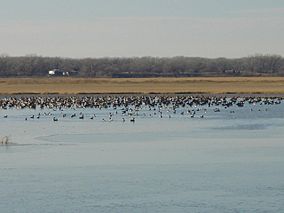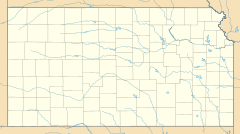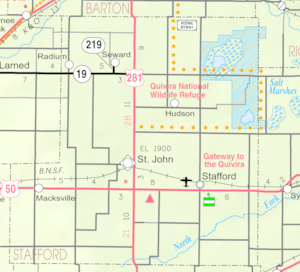Quivira National Wildlife Refuge facts for kids
Quick facts for kids Quivira National Wildlife Refuge |
|
|---|---|
|
IUCN Category IV (Habitat/Species Management Area)
|
|

Birds on one of Quivira's salt marshes
|
|
| Location | South central Kansas, United States |
| Nearest city | Stafford |
| Website | Quivira National Wildlife Refuge |
| Designated: | 2 December 2002 |
| Reference #: | 1172 |
The Quivira National Wildlife Refuge is a special place in south central Kansas, near the town of Stafford. It's mostly in Stafford County, but small parts reach into Rice and Reno Counties. This refuge is a fantastic spot for birds because it's close to the Central Flyway. This "flyway" is like a superhighway in the sky for birds migrating across North America. The refuge also has unique salt marshes, which are wetlands with salty water. These features bring a huge variety of birds, many of which are rare in other parts of Kansas or even the central United States.
In 2008, Quivira NWR and another area called Cheyenne Bottoms Wildlife Area were both named as one of the "8 Wonders of Kansas." Quivira NWR is also recognized internationally as a very important wetland. It's one of only 29 places in the United States on the Ramsar list. This means it's a wetland that is important for the whole world!
Contents
Discovering Quivira: A Fabled City
The name Quivira comes from an old story about a legendary Native American city made of gold. Back in 1541, a Spanish explorer named Francisco Vásquez de Coronado led an adventure onto the Great Plains of Kansas. He was searching for this amazing golden city and its riches.
Coronado spent about a month with the Quivirans, who were ancestors of the Wichita tribe. But even after all his searching, he didn't find any gold. He eventually went back to New Mexico without the treasure he hoped for.
About Quivira National Wildlife Refuge
The Quivira National Wildlife Refuge was created in 1955. By 1998, it grew to its current size of about 22,135 acres (89.6 square kilometers). A creek called Rattlesnake Creek flows through the middle of the refuge.
Quivira has two shallow lakes, Big Salt Marsh and Little Salt Marsh. These lakes have been attracting migrating birds and other animals for hundreds of years. To create even more marshland, 21 miles (34 km) of canals have been built. The refuge has 34 wetlands, which are areas of land covered with water. These wetlands range from 10 to 1,500 acres (4 to 607 hectares) in size, totaling about 7,000 acres (28 square kilometers). The water in these wetlands has high salt levels.
Quivira also has about 13,000 acres (53 square kilometers) of sand dunes. These dunes are covered with different types of prairie grasses. You can find plants from both the eastern Tallgrass prairie and the western Shortgrass prairie here. About 1,500 acres (6 square kilometers) of the refuge are wooded. You can see trees like cottonwood, black locust, and eastern redcedar.
Another 1,200 acres (4.9 square kilometers) of the refuge are used for farming. Farmers grow winter wheat and milo, but they leave some of the crops in the fields for the wildlife to eat. Cattle also graze on some parts of the refuge. This helps the land, as it's similar to how bison used to graze here long ago. Bison are no longer present, but their grazing was a natural part of the area's environment.
Exploring the Refuge
There are two main roads in the refuge for viewing wildlife. One is 14 miles (23 km) long, and the other is 4 miles (6.4 km) long. A 1.2-mile (1.9 km) nature trail lets you walk through woodlands, grasslands, and even across a marsh on a raised boardwalk. "Birdhouse Boulevard" is a 1,000-foot (300 m) trail that is friendly for wheelchairs and lined with birdhouses.
You can also find a wildlife observation tower on the south side of Little Salt Marsh. There are two special spots for photography and a spotting scope to help you see animals up close. Hunting for small game and waterfowl is allowed on 8,000 acres (32 square kilometers) of the refuge.
Near the Visitor Center, there's a "Kid's Fishing Pond" where children can fish. Fishing is also allowed in the marshes. You can ride bicycles and horses on the marked trails and roads. However, boats of any kind are not allowed.
Amazing Wildlife at Quivira
A huge number of bird species have been seen at Quivira National Wildlife Refuge – 344 different kinds! Most of these birds are only there during certain seasons. During the Christmas bird count in 2010, volunteers counted 43,548 birds from 95 different species. More than half of these were snow geese, which often spend the winter at the refuge.
Besides birds, Quivira is home to many other animals. You might see mule and white-tail deer, raccoons, coyotes, badgers, skunks, and opossums. There are also bobcats, red and swift foxes, beavers, muskrats, porcupines, prairie dogs, and wild turkeys. The refuge also has two types of lizards and six different kinds of turtles.
Spring and Summer Wildlife
During spring, many shorebirds, pelicans, and gulls stop at the refuge. They are on their way to their nesting grounds further north. Some birds, like plovers, avocets, stilts, ibis, and the endangered least terns, actually build their nests and raise their young right here at the refuge during spring and summer. Even whooping cranes, which are very rare, sometimes stop over on their journey north to their nesting areas.
Fall Wildlife
In the fall, Quivira NWR becomes a busy stop for migrating birds. About 800,000 geese and ducks pass through the refuge. They are on their long journey to warmer places like the Gulf Coast and Mexico for the winter. Endangered whooping cranes also sometimes visit the refuge in the fall as they head to their winter homes in Texas.
Winter Wildlife
When winter arrives, both bald eagles and golden eagles come to the refuge. They spend the colder months here, making Quivira a great place to spot these majestic birds.
Images for kids




